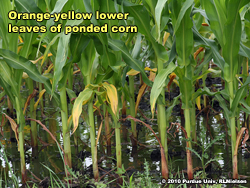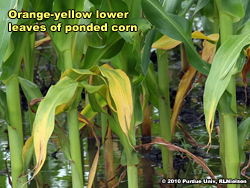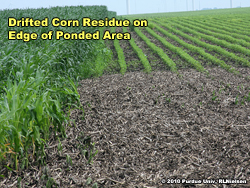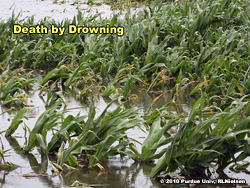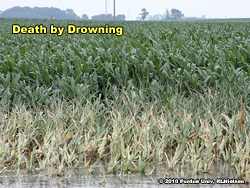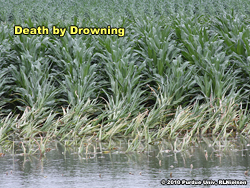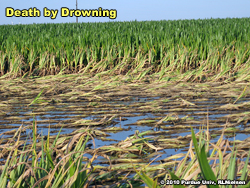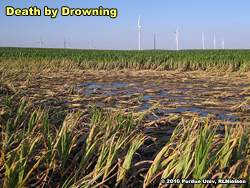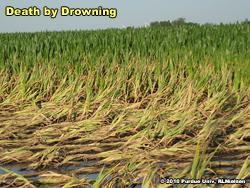June 2010
URL: http://www.kingcorn.org/news/timeless/DeathbyDrowning.html
Death by Drowning
R.L. (Bob) Nielsen
Agronomy Dept., Purdue Univ.
West Lafayette, IN 47907-2054
Email address: rnielsen
at purdue.edu
![]() ntense rainfall accompanying severe thunderstorms can quickly fill up the "ponds" or low-lying areas within crop fields that may not drain for days, especially if drainage ditches themselves run full for days after the storm. The common question in the coffeeshops the morning following such a "toadstrangler" event centers around how many days a corn crop can tolerate ponded conditions. The cynical answer to that question is "...until it dies."
ntense rainfall accompanying severe thunderstorms can quickly fill up the "ponds" or low-lying areas within crop fields that may not drain for days, especially if drainage ditches themselves run full for days after the storm. The common question in the coffeeshops the morning following such a "toadstrangler" event centers around how many days a corn crop can tolerate ponded conditions. The cynical answer to that question is "...until it dies."
When air temperatures are high, the crop well within the rapid growth period, and the plant's photosynthetic "machinery" is operating at full capacity following a ponding event, oxygen deprivation in the root zone quickly takes its toll on root health and the tissue begins to die quickly. The plants literally drown.
An early symptom of significant root death due to ponded or saturated conditions is the appearance of orange-yellow lower leaves on the corn plant. This discoloration often begins within a day after the ponding or saturation occurs and is distinct from the more common nitrogen deficiency symptom of yellow leaves. The photos that follow do not faithfully reproduce the vividness of the orangish cast to these lower leaves, but you should get the general idea.
With high temperatures, more serious deterioration of the crop can also occur within a day or two of stress by saturated soils. Once root function fails, the plants can no longer acquire enough moisture to fulfill the needs of photosynthesis. Wilting begins to occur and very much resembles that which you expect from a field under very severe drought stress. The wilting plants are most often obvious around the perimeter of the ponded or saturated area of the field.
Click on images to view larger versions.
Related Reading
Nielsen, RL (Bob). 2009. Flood Damage to Corn Near Pollination or Beyond. Corny News Network, Purdue Univ. [online] http://www.kingcorn.org/news/articles.09/FloodDamage-0807.html [URL accessed June 2010].
Nielsen, RL (Bob). 2010. Effects of Flooding or Ponding on Young Corn. Corny News Network, Purdue Univ. [online] http://www.kingcorn.org/news/timeless/PondingYoungCorn.html [URL accessed June 2010].
Other articles that address flood-damaged crops is available online at http://www.agry.purdue.edu/ext/corn/cafe/flood/index.html [URL accessed June 2010].

